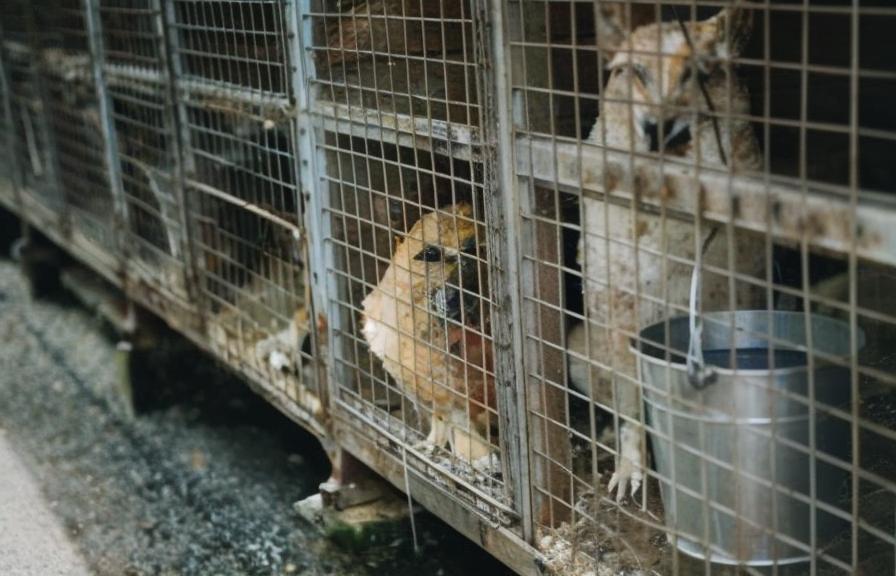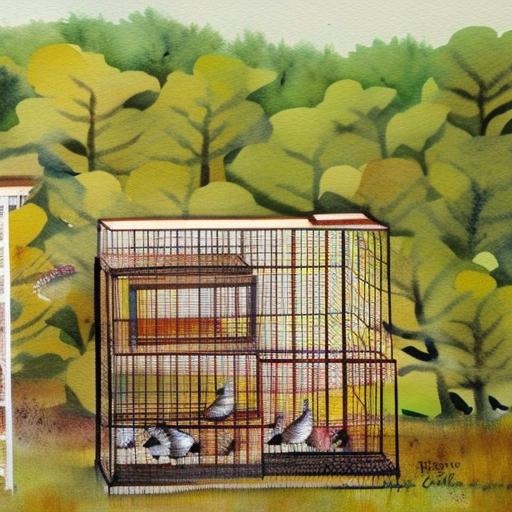Quail breeding cages are an essential tool for anyone looking to raise quail for meat or eggs. These cages provide a controlled environment for quail to live and reproduce, ensuring their safety and well-being while also making it easier for breeders to manage and monitor their flock. Quail breeding cages come in a variety of sizes and designs, each with its own set of benefits and considerations. Whether you are a seasoned quail breeder or just starting out, understanding the different types of quail breeding cages, how to choose the right one, and how to set up and maintain them is crucial for success in the industry.
Quail breeding cages are designed to mimic the natural habitat of quail while also providing the necessary space and resources for breeding and egg production. These cages typically feature wire mesh walls and floors to allow for proper ventilation and waste removal, as well as nesting boxes and perches for the quail to rest and lay eggs. Additionally, some cages may include feeding and watering systems to ensure that the quail have access to food and water at all times. By providing a safe and controlled environment, quail breeding cages help to minimize the risk of predation, disease, and other environmental factors that can impact the health and productivity of the quail flock.
Key Takeaways
- Quail breeding cages are essential for raising quails in a controlled environment, ensuring their safety and productivity.
- There are various types of quail breeding cages, including battery cages, colony cages, and brooder cages, each with its own advantages and disadvantages.
- When choosing the right quail breeding cage, factors such as size, material, ventilation, and ease of cleaning should be considered to ensure the well-being of the quails.
- Setting up and maintaining quail breeding cages requires regular cleaning, proper ventilation, and monitoring of temperature and humidity levels.
- Using quail breeding cages offers benefits such as efficient space utilization, disease control, and ease of monitoring and handling the quails.
Types of Quail Breeding Cages
There are several types of quail breeding cages available on the market, each with its own unique features and benefits. One common type is the battery cage system, which consists of multiple stacked cages that allow for efficient use of space and easy management of large quail flocks. These cages are typically made of galvanized wire mesh and can be customized with feeding and watering systems, as well as egg collection trays for easy access to the eggs. Another popular option is the colony cage system, which is designed to mimic the natural social structure of quail by housing multiple birds together in a larger, more open space. This type of cage allows for natural behaviors such as dust bathing and social interaction, but may require more space and careful management to prevent aggression and overcrowding.
In addition to these larger cage systems, there are also smaller individual cages available for breeders with smaller flocks or limited space. These cages are often designed with removable trays for easy cleaning and may include built-in nesting boxes and perches for the quail to use. Some breeders may also opt for homemade or DIY cage designs, using materials such as wood, PVC pipe, or wire mesh to create custom cages that meet their specific needs and preferences. Regardless of the type of quail breeding cage chosen, it is important to consider factors such as space requirements, ease of cleaning and maintenance, and the specific needs of the quail breed being raised.
Choosing the Right Quail Breeding Cage
When choosing a quail breeding cage, there are several factors to consider in order to ensure the health and productivity of the quail flock. The size of the cage is one of the most important considerations, as it will directly impact the comfort and well-being of the quail. The cage should provide enough space for the quail to move around freely, stretch their wings, and engage in natural behaviors such as dust bathing and nesting. Additionally, the cage should be large enough to accommodate the number of quail being raised, with sufficient room for nesting boxes, perches, feeding and watering systems, and waste removal trays.
Another important factor to consider when choosing a quail breeding cage is ventilation. Proper ventilation is crucial for maintaining good air quality within the cage and preventing issues such as ammonia buildup from waste. The cage should have adequate airflow to prevent overheating in hot weather and condensation in cold weather, while also protecting the quail from drafts and extreme temperatures. Additionally, the cage should be designed with easy access for cleaning and maintenance, with removable trays or floors that allow for quick waste removal and disinfection.
Finally, when choosing a quail breeding cage, it is important to consider the specific needs of the quail breed being raised. Different breeds of quail may have varying space requirements, social behaviors, and nesting preferences, so it is important to choose a cage that meets these specific needs. For example, some breeds of quail may require more space for nesting and egg laying, while others may be more social and prefer larger colony-style cages. By considering these factors when choosing a quail breeding cage, breeders can ensure that their flock remains healthy, productive, and content in their environment.
Setting Up and Maintaining Quail Breeding Cages
Once a quail breeding cage has been chosen, it is important to properly set up and maintain the cage to ensure the health and productivity of the quail flock. The first step in setting up a new cage is to thoroughly clean and disinfect it before introducing any quail. This helps to remove any potential pathogens or contaminants that could harm the quail, as well as create a clean environment for them to inhabit. Once the cage has been cleaned, it can be outfitted with nesting boxes, perches, feeding and watering systems, and any other necessary accessories.
Maintaining a quail breeding cage involves regular cleaning and monitoring to ensure that the environment remains safe and healthy for the quail. This includes removing waste from the cage on a daily basis, as well as regularly disinfecting surfaces to prevent the spread of disease. Additionally, it is important to monitor the temperature and humidity levels within the cage to ensure that they remain within a safe range for the quail. This may involve using fans or heaters to regulate temperature, as well as providing additional bedding or shelter during extreme weather conditions.
In addition to regular cleaning and maintenance, it is important to monitor the health and behavior of the quail within the breeding cage. This includes observing their eating and drinking habits, as well as their social interactions and egg production. Any changes in behavior or productivity should be addressed promptly to prevent potential issues from arising within the flock. By setting up and maintaining a quail breeding cage with care and attention to detail, breeders can create a safe and productive environment for their quail flock.
Benefits of Using Quail Breeding Cages
There are numerous benefits to using quail breeding cages for raising quail for meat or eggs. One of the primary benefits is that these cages provide a controlled environment for the quail, protecting them from predators, disease, and environmental hazards. This helps to ensure the safety and well-being of the quail flock, while also making it easier for breeders to manage and monitor their birds. Additionally, quail breeding cages allow for efficient use of space, making it possible to raise larger flocks in a smaller area while still providing adequate space for each bird.
Another benefit of using quail breeding cages is that they make it easier to collect eggs and manage breeding activities. Many cages are designed with built-in nesting boxes and egg collection trays, making it simple to gather eggs without disturbing the birds. Additionally, these cages can be customized with feeding and watering systems that provide easy access for both the birds and the breeder. This makes it easier to ensure that the quail have access to food and water at all times, while also allowing breeders to monitor their eating habits and adjust their diet as needed.
Quail breeding cages also help to minimize waste management issues by providing removable trays or floors for easy waste removal. This helps to keep the environment clean and sanitary for the quail while also reducing odors and potential health hazards associated with waste buildup. Additionally, these cages can be designed with proper ventilation systems that help to maintain good air quality within the environment, preventing issues such as ammonia buildup from waste.
Common Issues and Troubleshooting for Quail Breeding Cages

While quail breeding cages offer numerous benefits for raising quail, there are also some common issues that breeders may encounter when using these cages. One common issue is aggression among birds in colony-style cages, which can lead to injuries or decreased productivity within the flock. To address this issue, breeders can provide additional space or hiding spots within the cage to give birds a chance to escape aggressive behavior. Additionally, separating aggressive birds from the rest of the flock may be necessary in some cases.
Another common issue with quail breeding cages is maintaining proper temperature and humidity levels within the environment. Extreme temperatures can stress or harm the quail, while high humidity levels can lead to issues such as mold growth or respiratory problems. To address these issues, breeders can use fans or heaters to regulate temperature as needed, as well as provide additional bedding or shelter during extreme weather conditions. Additionally, monitoring humidity levels with a hygrometer can help breeders maintain a safe environment for their quail.
Maintaining good air quality within a quail breeding cage is another common issue that breeders may encounter. Poor ventilation can lead to issues such as ammonia buildup from waste or respiratory problems in the birds. To address this issue, breeders can ensure that their cages have adequate airflow by using fans or vents as needed. Additionally, regularly cleaning waste from the cage can help prevent odors and maintain good air quality within the environment.
Conclusion and Final Tips for Quail Breeding Cage Success
In conclusion, quail breeding cages are an essential tool for anyone looking to raise quail for meat or eggs. These cages provide a controlled environment for quail to live and reproduce while also making it easier for breeders to manage and monitor their flock. When choosing a quail breeding cage, it is important to consider factors such as size, ventilation, and specific breed needs in order to ensure success in raising healthy and productive quail.
Setting up and maintaining a quail breeding cage involves thorough cleaning and disinfection before introducing any birds, as well as regular monitoring of temperature, humidity levels, waste removal, and bird behavior. By paying attention to these details and addressing common issues such as aggression among birds or maintaining proper environmental conditions, breeders can create a safe and productive environment for their quail flock.
In addition to these considerations, it is important for breeders to stay informed about best practices for raising quail in breeding cages by seeking out resources such as books, online forums, or local breeders’ associations. By staying informed about new developments in quail breeding techniques and equipment, breeders can continue to improve their methods and achieve success in raising healthy and productive quail flocks.
If you’re interested in quail breeding cages, you may also want to explore some helpful resources on chicken coop designs and setups. Poultry Wizard offers a variety of articles on keeping chickens, including tips for building a chicken coop and run, creating a country diner for your chickens, and turning a shed into a functional chicken coop. These articles provide valuable insights and ideas for creating comfortable and efficient living spaces for your poultry. Check out their article on chicken coop run plans to learn more about optimizing space for your birds.
FAQs
What are quail breeding cages?
Quail breeding cages are specially designed enclosures used for housing and breeding quail. These cages are typically equipped with features that provide a suitable environment for quail to lay eggs, incubate them, and rear their young.
What are the benefits of using quail breeding cages?
Quail breeding cages offer several benefits, including efficient use of space, ease of management, and the ability to control breeding and egg collection. They also help to protect quail from predators and provide a clean and hygienic environment for breeding.
What features should quail breeding cages have?
Quail breeding cages should have adequate space for the quail to move around, perches for roosting, nesting boxes for laying eggs, and a removable tray for easy cleaning. They should also be well-ventilated and provide protection from extreme weather conditions.
How should quail breeding cages be set up?
Quail breeding cages should be set up in a quiet and sheltered area, away from direct sunlight and drafts. The cages should be placed on a level surface and lined with suitable bedding material. It’s important to ensure that the cages are secure and predator-proof.
What are the considerations for selecting quail breeding cages?
When selecting quail breeding cages, it’s important to consider the size of the cages, the material they are made of, and their ease of cleaning and maintenance. The cages should also be designed to meet the specific needs of the quail breed being raised.
Meet Walter, the feathered-friend fanatic of Florida! Nestled in the sunshine state, Walter struts through life with his feathered companions, clucking his way to happiness. With a coop that’s fancier than a five-star hotel, he’s the Don Juan of the chicken world. When he’s not teaching his hens to do the cha-cha, you’ll find him in a heated debate with his prized rooster, Sir Clucks-a-Lot. Walter’s poultry passion is no yolk; he’s the sunny-side-up guy you never knew you needed in your flock of friends!







